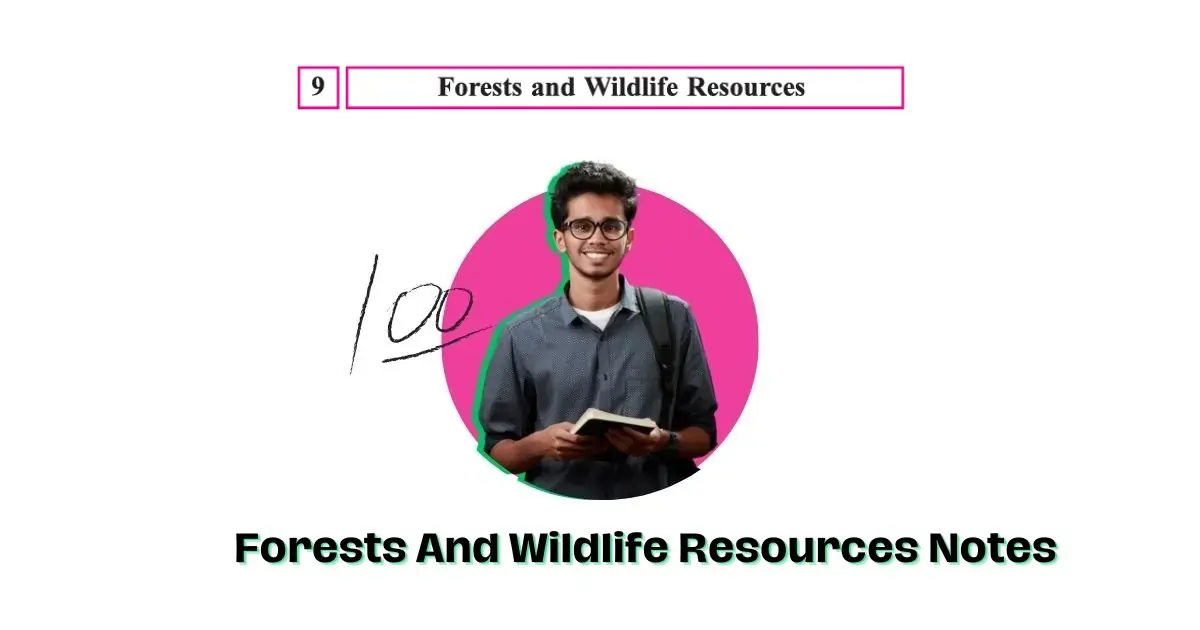Forests and Wildlife Resources Notes | GSEB Class 10 S.S Notes
Natural Resources Notes | GSEB Class 10 S.S Ch 08 Notes
Classification Of Forest Notes
Types of Forests According to Administration:
Reserved Forests:
- Directly controlled by the Government.
- Restrictions on lumbering, wood collection, and pasturing.
Protected Forests:
- Administered by local administration.
- Local people permitted to collect wood and graze animals without harming trees.
Unclassified Forests:
- Not yet classified.
- No restrictions on tree felling or animal grazing.
Classification of Forests According to Ownership, Administration, and Management:
State Forest:
- Controlled by Central or State Government.
- Majority of the country’s forests fall under this category.
Communal (Community) Forest:
- Controlled by Local Self Government institutions (Gram Panchayat, Municipalities, Corporations, District Panchayat).
Private Forest:
- Owned by individuals.
- Predominantly found in Odisha, Meghalaya, Punjab, and Himachal Pradesh.
- Some forests in poor condition or barren.
Deforestation Notes
Deforestation is the widespread destruction of forests, primarily caused by human interference, leading to environmental degradation and various adverse impacts on ecosystems and wildlife.
Impact of Deforestation:
- Increase in atmospheric carbon dioxide.
- Intensification of greenhouse effects.
- Soil erosion due to removal of forest cover.
- Decrease in farm fertility.
- Significant deforestation in peninsular India.
- Loss of habitat for many living organisms.
- Wild animals migrate towards urban areas in search of food and water.
- Instances of carnivorous animals attacking domestic animals near forests are recorded.
Remedies for Forest Conservation Notes
- Research to find wood alternatives can reduce forest usage.
- Mandatory afforestation for industries reliant on forest resources is essential.
- Strict regulations under eco-tourism must protect forest covers.
- Public awareness campaigns are crucial for local communities.
- Education curriculums should emphasize forest conservation.
- Intensive development of social forestry and agro-forestry is necessary.
- Implementation of alternative energy sources like solar power and natural gas can reduce reliance on firewood.
- Sustainable use of forest resources is vital, including timely removal of infested trees.
- A national-level force should be established to combat forest fires.
- Proper waste management during religious gatherings in forested areas is essential to prevent pollution.
- Designating and preserving areas for animal pasture is important for ecosystem balance.
Wildlife Diversity
- India’s diverse climate and geography support a wide range of wildlife.
- With approximately 81,251 species, India ranks 12th globally in biodiversity.
- It hosts animals from Asia, Europe, and Africa, including tigers, lions, elephants, gibbons, and various bird species.
- Notable species include the snow leopard, red panda, and sea turtles.
- Migratory birds visit Keoladev National Park and Nal Sarovar during winter.
- Southern rainforests house Indian pythons, snakes, and the King cobra.
Notes on Wildlife Extinction Crisis:
- Many wild animals globally are facing extinction.
- Tigers, once widespread in India, are now extinct in Gujarat forests.
- Cheetahs are also disappearing from Indian forests.
- Numerous bird species are becoming increasingly rare in Indian forests.
- Birds like vultures, pink-throated ducks, cranes, and owls are on the brink of extinction.
- The Chilotro bird, once abundant in Arunachal Pradesh, is now rare.
- Alligators in freshwater rivers and Ganga River Dolphins are at risk.
- Sea turtle populations near Odisha and Gujarat coasts are declining.
- Water-fowl, previously abundant in rivers like Narmada, Tapi, Mahi, and Sabarmati in Gujarat, are nearly extinct.
- Urgent action is needed to address this issue.
Reason For destruction Of WildLife
- Human interference threatens wild habitats.
- Deforestation reduces wildlife numbers.
- Hunting for various purposes endangers species.
- Overexploitation of forests displaces animals.
- Encroachment for resources threatens wildlife.
- Forest fires negatively impact species.
- Loss of habitats leads to human-animal conflicts.
- Hunting for bio-medicine and perfume ingredients endangers species.
Measures Of Preservation Of Wildlife
- Shift perception of forests from income sources to vital ecosystems for wildlife preservation.
- Maintain herbivore-carnivore balance by protecting water sources and limiting domestic animal grazing.
- Enforce strict anti-hunting laws with severe penalties and deter illegal mining in forests.
- Implement measures to avoid disturbance to wildlife during breeding seasons.
- Conduct studies on impacts of activities like fishing and tourism on wildlife and take appropriate action.
- Organize widespread awareness programs on wildlife conservation.
- Ensure active wildlife protection forces and prioritize their duties.
Sanctuaries, National Parks and Bio-reserve:
Sanctuary:
- Permits limited human activities.
- Allows domesticated animals to graze with permission.
- Established by the government for specific species protection.
- Examples: Periyar, Chandraprabha, Eturnagaram.
National Park:
- More protected than sanctuaries.
- Contains multiple ecosystems.
- Bans animal grazing.
- Established through coordination of State and Central Governments.
- Examples: Kaziranga, Corbett, Velavadar, Marine National Park, Gir, Dachigam.
Biosphere Reserve:
- Established according to international norms.
- Protects physical, cultural diversity, and lifestyle of residents.
- Facilitates research and training.
- Completely restricts human movements.
- Typically spans over 5000 sq. kilometers.
- Examples: Nilgiri, Gulf of Mannar, Great Nicobar, Sundarbans, Pachmarhi.
Development must consider environmental impact to avoid disrupting the delicate balance of ecosystems.
Disruption of one species affects the entire food chain, with consequences often felt long after. Planned development and environmental-friendly approaches are crucial in the present era.
| Category | Sanctuary | National Park | Biosphere Reserve |
|---|---|---|---|
| Purpose | Protect specific species | Protect multiple ecosystems | Protect physical, cultural diversity |
| Human Activities | Permitted within limits | Restricted | Completely restricted |
| Animal Grazing | Allowed with permission | Banned | Banned |
| Establishment | Government after due process | Coordination of State and Central Governments | According to international norms |
| Examples | Periyar, Chandraprabha, Eturnagaram | Kaziranga, Corbett, Velavadar, Marine National Park Gir, Dachigam | Nilgiri, Gulf of Mannar, Great Nicobar, Sundarbans Pachmarhi |

